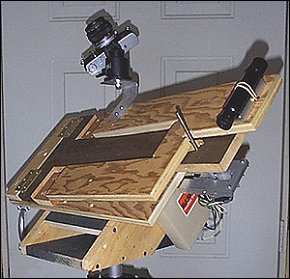 |
|
|
 |
|
|
|
Build a Barn Door Tracker
Introduction
Camera mounts of this design are also called Haig or Scotch mounts. I built an earlier, manually operated version of the mount in the winter of 1997, for the apparition of Comet Hale-Bopp. The modest success of the manual version encouraged me to motorize it.
A barn door is a specialized type of equatorial mount. The mount shown here employs a Type 4 double arm design. The double arm design was first described in an article by Dave Trott, published in the February, 1988 issue of Sky & Telescope magazine. A followup appeared in the April, 1989 issue.
The dimensions and geometry of the mount are chosen such that a ¼"-20 (.25-inch diameter, 20 threads-per-inch) drive screw, turning at precisely one revolution per minute (rpm), will drive the camera platform at the sidereal rate. The mount compensates for the rotation of the earth, allowing the camera to track the apparent motion of the sky. Drive screws of other sizes can be used, with corresponding changes in the dimensions of other components.
To track properly, the axis of the mount's hinges (its Right Ascension axis) must point precisely at the celestial pole. In the northern hemisphere, the celestial pole is near Polaris (the North Star). The elevation angle required is equal to the observer's latitude. A finder scope parallel to the hinges is used to polar-align the mount.
A sturdy Bogen photo tripod provides a solid base. Rather than attach the mount to a pan-and-tilt tripod head, I built a wooden latitude wedge that mounts directly to the top of the tripod. This provides a very stable platform.
A stepper motor with a 30:1 planetary gearbox turns the drive screw. A digital control circuit with a quartz timebase drives the motor at the required one rpm.
I found all of the information — and many of the components — needed to design and construct this mount on the Web. I could not have done it without the information provided on the web and via e-mail from other barn door builders. Check my list of Helpful Links.
| ||||||||||||||||||||||||||||||||||||||||||||||||||||||||||||||||||||||||||||||||||||||||||||||||||||||||||||||||||||||||||||||||||||||||||||||||||||||||||||||||||||||||||||||||||||||||||||||||||||||||||||||||||||||||||||||||||
